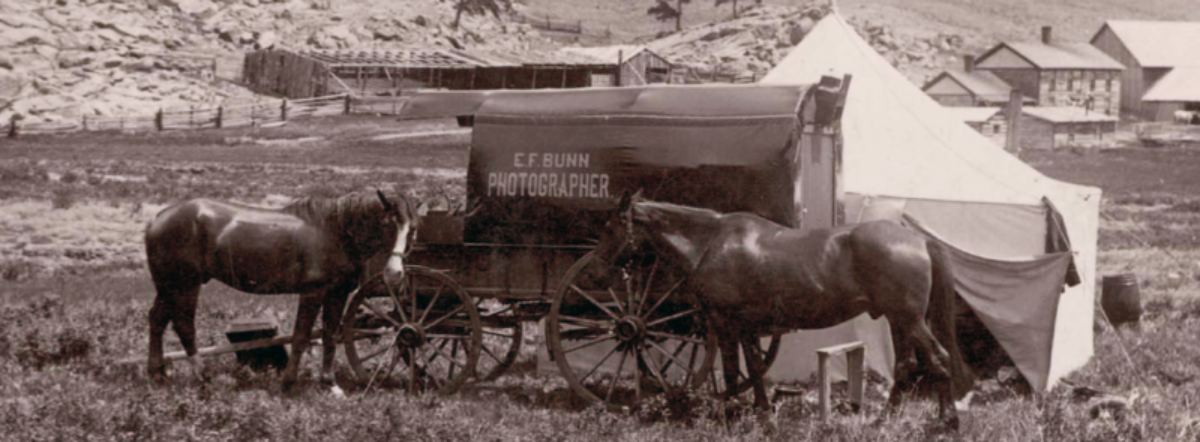
Many 19th century photographers combined their careers with mining activities, moving West with the dream of finding gold. John C. H. Grabill (c.1850-1903) followed this pattern. Grabill was born around 1850 at Donnelsville, Ohio, to David and Catharine Kee Grabill. One decade later, the census shows the Grabills living in Champagne, Illinois.
By late 1880 John Grabill was mining near Aspen, Colorado, later expanding his holdings to mines in Chaffee and Gunnison counties. He purchased an assaying outfit from Chicago that allowed him to distinguish the properties and value of his finds. Grabill opened an assay office in Buena Vista, Colorado, that was known as one of the best in the state (Buena Vista Democrat, March 15, 1883, p3, c3). A fire on March 9, 1883, likely caused by a defective flue, destroyed the entire business block that housed Grabill’s office (Gunnison Review-Press, March 9, 1883, p1, c2). Later that month he opened a new brick office, continuing to offer his indispensable services to the miners. He also provided electroplating services for cutlery and jewelry.

In December 1885 Grabill announced that he would open a photography studio in Buena Vista, Colorado. The studio, located on San Juan Avenue, opened in March 1886, next door to his assay office. One of his early photos shows both of his businesses (see left).
Grabill moved his studio to the wild west town of Sturgis, Dakota Territory, in the fall of 1886. His photographs capture the day-to-day life of the area– a street crowded with ox teams and rounding up cattle on the Belle Fourche River. In 1888, Grabill added another studio, about fifteen miles west of Sturgis in Deadwood, splitting his time between the two locations. The new studio was an elegant space in the Nye building, at the corner of Gold and Main streets. He photographed historical landmarks, such as the famous Deadwood Stage Coach’s last trip before being superseded by the railway, the recently completed Deadwood Central Railroad, and Deadwood’s July 4th celebration.
Deadwood’s holiday festivities included events for the Chinese immigrants who came to the city in the mid-1870s in numbers large enough to form their own Chinatown neighborhood. The immigrants supported the town’s mining industry, running businesses like restaurants and laundries. Two Chinese fire hose teams, both from Deadwood, competed in the world’s first Hub-and-Hub race by Chinese teams. The teams, outfitted in fancy uniforms, ran a 300-yard dash, pulling their equipment. The team under the direction of Hi Kee, a Chinatown merchant, was the first to couple their hoses and pump water, winning the contest. This race was followed by eight White hose teams with a purse of $500.00

In the early 1890s, Grabill produced extensive documentation of Native Americans, including views made at Pine Ridge in January 1891, just weeks after the Battle of Wounded Knee and the death of Sitting Bull.
Grabill incorporated The Grabill Portrait and View Company in 1891 with studios planned for Baltimore, Boston, Chicago, New York, and Omaha (The Black Hills Daily Times, April 4, 1891, p4, c5). But the company was soon bankrupt and Grabill’s pictures were auctioned off to cover a $340.43 debt (The Daily Deadwood Pioneer-Times, March 8, 1892, p3, c2). The firm of Locke & McBride took over Grabill’s Deadwood studio.
In 1901, Grabill lived in St. Louis and worked as a salesman for a mining supply company. His mental health deteriorated and by early 1903 he was a resident at the St. Louis City Insane Asylum. Grabill died there on August 23, 1903. He is buried at Saint Matthew Cemetery in St. Louis.

The Library of Congress collection of Grabill photographs. https://www.loc.gov/pictures/collection/grabill/
Additional biographical information: https://en.wikipedia.org/wiki/John_C._H._Grabill












